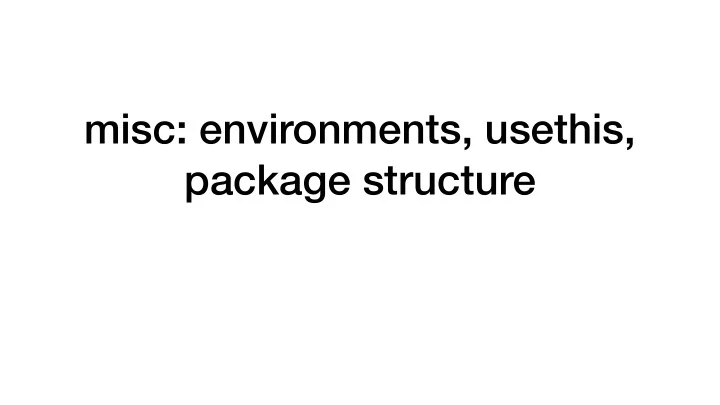

misc: environments, usethis, package structure
Environments
Environments and bindings via Hadley Wickham
Can be recursive via Hadley Wickham
Parent environments via Hadley Wickham
Empty environment via Hadley Wickham
Search path via Hadley Wickham
Search path via Hadley Wickham
<<- (super assignment)
Your Turn If we don’t have any packages loaded, what is the second thing in R’s search path? A fu er loading library(tidyverse) what is the second thing in R’s search path? Hint: you probably want to review the search() function from lecture 10.
Hidden * files
Use ::: to see “Non-Visible functions are asterisked” > methods("plot") [1] plot.acf* plot.data.frame* plot.decomposed.ts* plot.default plot.dendrogram* plot.density* [7] plot.ecdf plot.factor* plot.formula* plot.function plot.hclust* plot.histogram* [13] plot.HoltWinters* plot.isoreg* plot.lm* plot.medpolish* plot.mlm* plot.ppr* [19] plot.prcomp* plot.princomp* plot.profile.nls* plot.raster* plot.spec* plot.stepfun [25] plot.stl* plot.table* plot.ts plot.tskernel* plot.TukeyHSD* see '?methods' for accessing help and source code > plot.acf Error: object 'plot.acf' not found > stats:::plot.acf function (x, ci = 0.95, type = "h", xlab = "Lag", ylab = NULL, ylim = NULL, main = NULL, ci.col = "blue", ci.type = c("white", "ma"), max.mfrow = 6, ask = Npgs > 1 && dev.interactive(), mar = if (nser > 2) c(3, 2, 2, 0.8) else par("mar"), oma = if (nser > 2) c(1, 1.2, 1, 1) else par("oma"), mgp = if (nser > 2) c(1.5, 0.6, 0) else par("mgp"), xpd = par("xpd"), cex.main = if (nser > 2) 1 else par("cex.main"), verbose = getOption("verbose"), ...)
usethis
usethis A new package by Jenny Bryan to make your life easier “usethis is a workflow package: it automates repetitive tasks that arise during project setup and development, both for R packages and non- package projects.” install.packages(“usethis”) or library(devtools) devtools::install_github("r-lib/usethis")
usethis
usethis For example git_sitrep() and use_git_config(user.name="Amelia McNamara", user.email="amelia.mcnamara@stthomas.edu")
Both together with usethis create_from_github("tidyverse/forcats", protocol = "https") By default, this creates the folder on your Desktop, but you can change where it goes using the destdir argument
One way to fork
One way to clone
Follow instructions from GitHub-first workflow
Your Turn Fork and clone the forcats repo onto your “computer” (either physical or RStudio Cloud) What happens?
You should now have an RStudio project open with all the code from the forcats package You can also go on GitHub to view the main version of the code, at https://github.com/ tidyverse/forcats and your version of the code, at https://github.com/[whatever your GitHub username is]/forcats. For example, mine is at https://github.com/AmeliaMN/forcats
We should now have a build tab
Your Turn Click the Install and Restart button on the Build pane. What happens?
Your Turn Poke around in the package for a bit. What kinds of files are in the R directory? What do they look like? What kinds of files are in man? What do they look like?
Your Turn Make a change to the documentation of one of the functions (for example, fct_recode ). Save your change. Install and Restart. If you ? your function, do you see the change? ?fct_recode
Your Turn What button do you have to click to get your change to the documentation to show up? What files are changed?
Recommend
More recommend